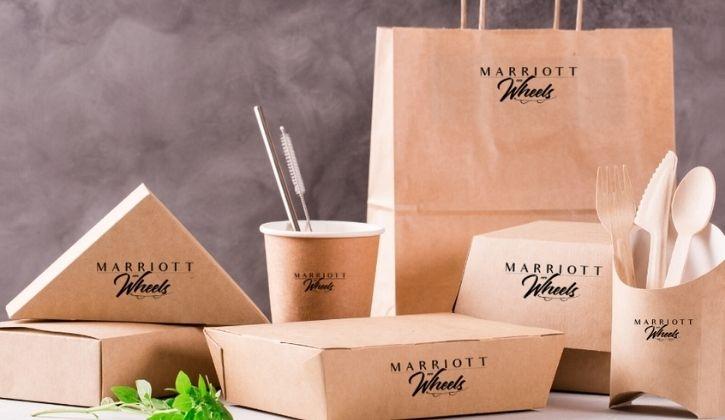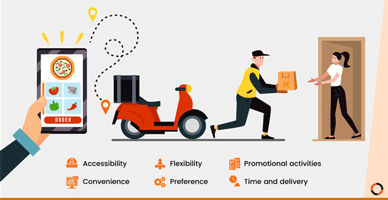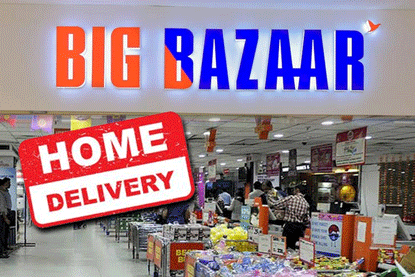CUSTOMERS: Large grocery chains like Big Bazar and their local counterparts like Delfinos, Magsons and Borkers have been compelled to offer home delivery because customers are reluctant to come to the stores for fear of covid infection. Which is why Arvind Kejrival has been suggesting that even rations should be distributed door-to-door.
By Krystina Shveda
Mega grocery chains like Big Bazaar, Godrej Green Basket and My Dukaan in India and the largest stores in UK like Harrods, have been badly effected by Covid-19. The problem starts with the supply chain which is disrupted due to lockdowns in the sourcing centres; since customers are reluctant to come to the shops, they have to adopt the home delivery model popularised by Amazon.
The strain on supermarkets as a result of Covid-19 has given some reason to believe that shorter supply chains and home deliveries are the future. But it’s a huge challenge to get food from field to doorstep.
When Covid-19 first began to engulf Europe, and some rushed to the supermarkets to stockpile, others hit the keyboards. Worldwide Google searches for “food delivery” and “local food” reached all-time highs in April. In the UK, people were six times more likely to look for “veg boxes” than a year ago. The crisis made us all re-examine how we get our groceries and where they come from.
WAITLIST CLIENTS
With the lockdown pressure piling up, supermarkets and delivery giants like Ocado and Amazon Fresh quickly became overwhelmed. Even popular UK vegetable box suppliers, such as Farmdrop and Riverford, had to introduce online queues and wait-list new customers. Meanwhile, hyperlocal and alternative food projects adapted faster and were able to close the gaps in the unravelling globalised food system. In just two months, over 500 British veg box providers, with waiting lists ranging from 160 to 6,700 customers, delivered 3.5 million boxes of fresh produce to homes – more than double their usual sales.
Local initiatives such as box schemes and online farmers’ markets diversify both what we eat and how we get it. This strengthens the resilience of the food system by reducing our dependence on one particular retailer – the supermarket.
“Supermarkets are very efficient at providing a lot of food for a lot of people but they have their vulnerabilities,” says Moya Kneafsey, professor in food and local development at Coventry University. In Britain, for example, only 17% of fruit and half of vegetables are grown locally – the rest comes from cheap international trade, as supermarkets promote year-round availability. “Covid-19 begs the question – will the imports we rely on be dependable in the future? Even if supply is OK at the moment, will it be affected by the long-term impact of the virus in producer countries and in the transport sector?”
STORAGE CAPACITY
The average storage capacity of a supermarket is only one day’s worth of fresh products, says Jan Willem van der Schans, senior researcher of new business models at Wageningen University and Research. This supply chain needs a buffer – extra provision for when international trade or logistics are disrupted. “Every country has its comparative advantage – we grow bananas in tropical zones and we grow kale in temperate zones, but locally-produced food could be that buffer in the future.”

NARROW PRODUCT RANGE
There are other downsides of overly relying on supermarket chains, which have more than a 95% grocery market share in the UK and France. Their products use a narrow range of ingredients based on crops and varieties that grow the fastest or are the most efficient to produce in large quantities. Industrial agriculture causes environmental degradation and relies on monocultures which are susceptible to disease. And the whole system tends to support low wages and temporary jobs. Almost a third of agriculture and fishing workers and 38% of food retail and wholesale workers in the UK are paid below the living wage. In the developing world, half of agricultural workers live in poverty – on less than $3.10 (£2.55) per day.
In contrast, local systems with fewer steps between the grower and the consumer often support organic and sustainable farms, which are committed to paying fair wages and are more community-driven and diverse, says Kneafsey. They also offer transparency – something that extended supply chains are not usually able to provide. Yet, only 2% of fresh food in the EU is sold directly between farmers and consumers. In the US, food sold directly to consumers by farmers accounted for $3bn (£2.36) in 2015 while grocery store sales, including supermarkets, accounted for $613bn (£483) in the same year.
When leaders around the world began to announce lockdown measures at the end of March, many farmers were left with tonnes of produce at risk of going bad because of restaurant closures.
SURPLUS PERISHABLES
In response, some online marketplaces have tried to match producers with surplus perishable produce to new customers in an attempt to replace lost trading relationships. The iTradeNetwork, for example, offered its online platform to companies struggling to sell or buy food during the crisis. But others have sought to change their approach to supplying food altogether.
In the US, the Community Supported Agriculture (CSA) scheme allows consumers to buy shares in community farms in return for regular deliveries of food throughout the season. This means that smaller farms get a cash injection at the start of each season when their costs, such as buying seeds, are highest. The supporters also feel a sense of reward for aiding a community project. With the arrival of coronavirus, many more farmers have been signing up to take part in these schemes.
Other community schemes have also prospered. Pale Green Dot, a small distributor that specialised in providing local and sustainable ingredients to chefs, found a way to help their partner farms.
“We went from 100% commercial versus 0% domestic sales to 5% versus 95%,” says Jo Farish, its head of business development. “Our chief technology officer rebuilt the website overnight to add home deliveries.” Within days, the company moved into larger premises, launched new logistics software and increased its van fleet from six to more than 40 to supply south east England with boxes of its own vegetables and other staples from partners in its network.
No food went to waste – Pale Green Dot had a long-standing relationship with charities, such as The Felix Project and Hospitality for Heroes, who took large initial surplus and cooked nutritious meals for the most vulnerable communities.
Just like Pale Green Dot, scores of food businesses and smaller local food producers across the world pivoted to the much-needed home deliveries after seeing their turnover disappear overnight. Wholesale suppliers, pop-up restaurants, neighbourhood cafes and butchers were all suddenly assembling food boxes.
In Eastern Ukraine, a small shop owner found an unconventional way to save her business and feed the city. Oksana Pilipey has a greengrocers’ in Rivne. Every morning at 6am, she posts pictures of the fresh supply of tomatoes, apples and other produce directly in a group chat on Viber, a messaging app. She then collects the orders and sends out a van with packages, grouping deliveries by district. “Many of my customers are ordering food for their self-isolating parents,” says Pilipey, whose group chat has over a thousand members. “The demand is huge.”
Online shopping for food is not widespread in Eastern Europe – but people have long relied on farmer’s markets which are now moving to social media in light of virus fears. Almost every town in Belarus, and many towns in other Eastern European countries, has a Viber group with makeshift marketplaces, satirically named “baraholka” – from the Russian barahlo, meaning “tat” – where locals buy and sell pretty much anything, including home-grown food. Eggs delivered to your door. Surplus milk from a local cattle farm. Apple tree saplings, anyone?
In east London, a baker had just re-opened his cafe with a local produce shop, Doh, two weeks before the lockdown. It took Jason Griffiths and his four associates months of preparation to select quality ingredients, establish links with independent food creators and organise the space. Determined not to give up, Doh’s team started cycling around the neighbourhood delivering boxes with farmers’ vegetables, the bread Griffiths bakes, as well as tempeh, vegan cheese and other goods locally prepared by small enterprises in Hackney Wick.
This culture of growing and exchanging food has many benefits, scientists argue, as it increases self – sufficiency but also creates helpful bonds between people, develops skills and enhances wellbeing.

LAST MILE PROBLEM
So would we be better off moving to deliveries of food from local producers and suppliers?
Many European farmers choose to sell their produce to supermarkets, despite retaining under a third of the retail price on average, as it is more efficient and reliable. Bringing produce into the city – the “last mile” problem – is very expensive, says van der Schans. The time pressure to deliver a box within a small time window is enormous, and there are few free delivery parking spaces in cities.
“Online delivery is not yet a very sustainable alternative to going to the supermarket, especially not if you go there by cycling or walking,” he says. He adds the possibilities for using green electric vehicles are growing and some smaller deliverers are making a conscious effort. But in practice, the vehicles that deliver the online shopping during lockdown are often old diesel vans.
Then there is the packaging. “Some box schemes are working on this but the pile of packaging material in most online deliveries is too big, it produces a lot of waste,” van der Schans says.
Online suppliers also have to create a suitable service level. Many box schemes set up regular subscriptions on a set range of products to optimise the production and reduce waste. This requires a different consumer behaviour that may be convenient for lockdown but not necessarily going forward. “How many people are adapted to buying food only once a week?” says van der Schans. “Convenience is a very powerful motivation.”
Maarten Bouten is a co-founder of Rechtstreex, an ethical distributor in Rotterdam. He says most of his turnover comes from collection points that are open one afternoon per week – and since the crisis the demand has tripled.
“Our pick-up points are not just for distribution – we are also building a social system in each neighbourhood,” he says. Collection points are run by a local coordinator – it’s the same person each week, so customers get to know them and can discuss the products, the farms and even how to prepare food.
Rechtstreex in Dutch is a word play on “direct” – the food is sourced directly from farmers located at a maximum of 50km (31.2 miles) from the city. All farmers have a profile page on the website and get 56 cents for each Euro that customers spend. Finding a balance between giving farmers a fair income and making healthy food affordable is one of the toughest issues food systems need to solve.
This has been, perhaps, the biggest barrier preventing customers switching to local produce deliveries: the price. Most veg boxes are more expensive than supermarket groceries, highlighting the real cost of food production, one that doesn’t rely on cheap international trade, environmental depletion and poor working conditions. But it makes them only affordable to the more affluent. This is a systemic problem – in the UK, unhealthy products are three times cheaper than healthy ones. And while 78% of Britons agree it is important to support local farmers, only 38% are prepared to pay more for British food.
“The governments want the consumers to be in control, to make the conscious choice – but only the consumers with high incomes will be able to make responsible choices, the consumers with low incomes cannot afford it,” says van der Schans. Food production should be part of the discussion on public health, not just agricultural policy, he argues.
Promoting cheap food is not an answer to food poverty, warns Kneafsey, if it means lower food quality, environmental damage and keeping wages low – creating a vicious circle. It hasn’t solved the problem so far and it doesn’t address the root causes of poverty and social inequalities.
Alternative food projects are well aware of the problem. One in 10 of the box schemes surveyed by the Food Foundation offered discounts to the vulnerable or asked community members who could afford it to subsidise boxes for them.
But in order to stay economically viable long-term, sustainable food initiatives must get state support, reiterate both Kneafsey and van der Schans. With the current legislation, most of the independent growers are too small to qualify for subsidies. Investment would help them to increase supply, by funding the extra staffing, infrastructure and protective equipment they need. It could also help them to prepare for when and if the boom in demand passes.
The Covid-19 crisis started a wave of innovations and raised awareness of how our food systems work “[But] we need to make sure this new attention benefits not only the new initiatives but also those sustainable, organic and farmer-friendly systems that have been around for over 20 years, with limited help and recognition from the governments,” van der Schans says.
A little help could go a long way. Even a Viber group in able hands can work magic.
Coutersy:www.bbc.com
